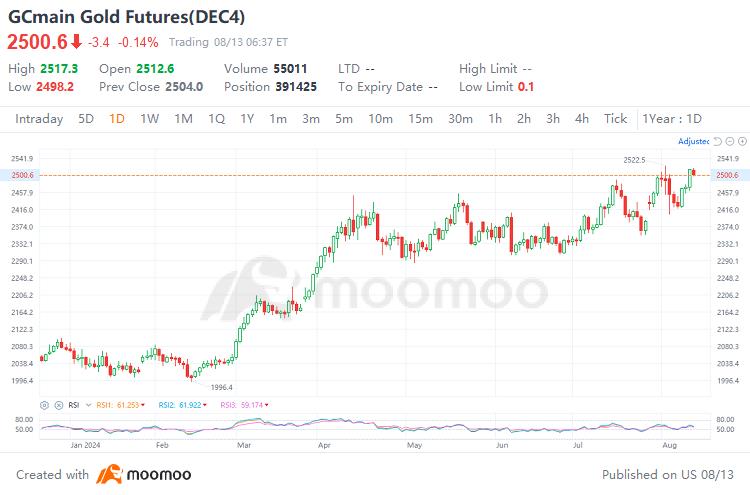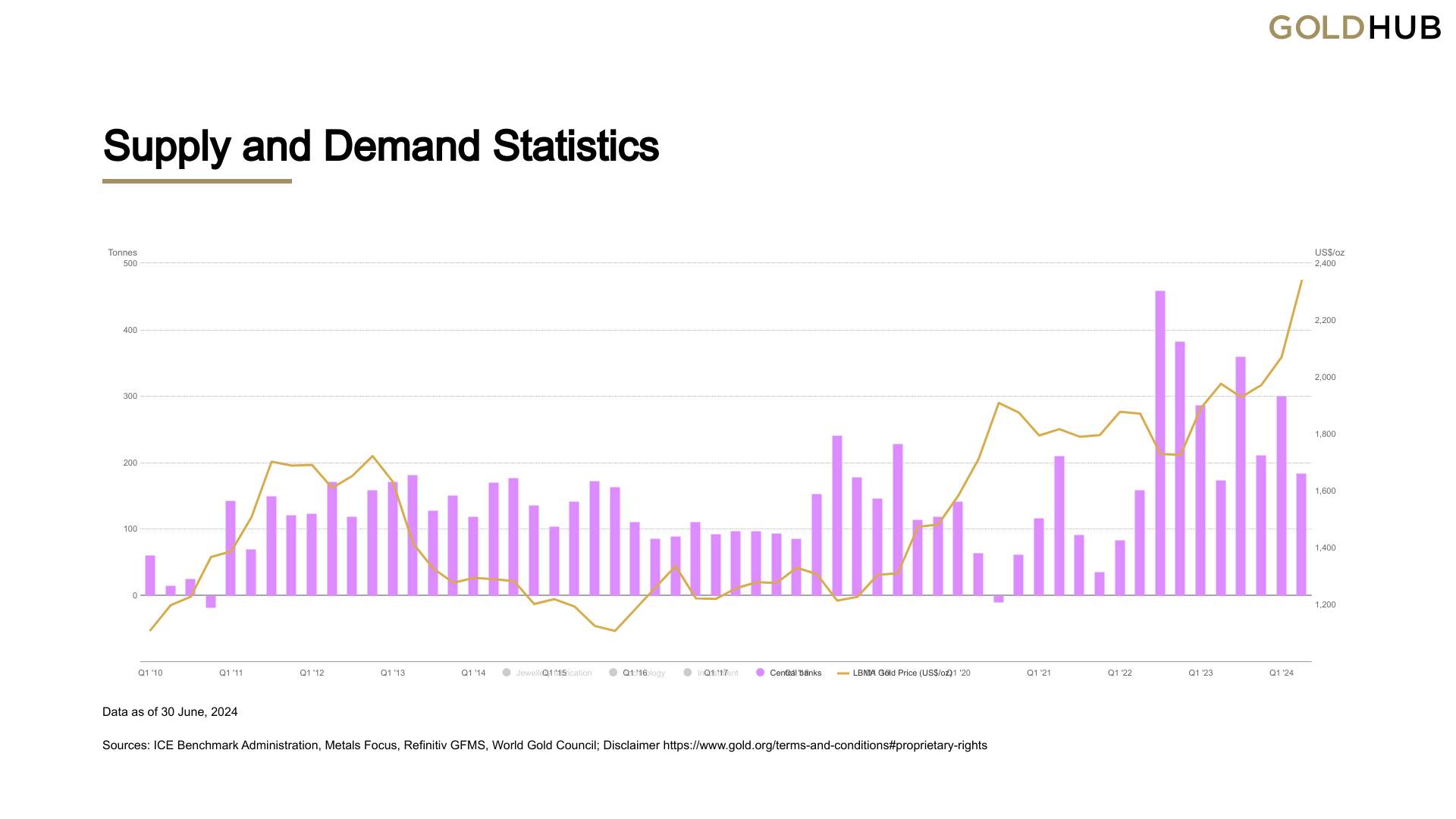5 reasons why gold may continue to shine after new high
Gold performance
As of August 13, spot gold is reported at $2,463 per ounce, and futures gold is at $2,503 per ounce, just a step away from the historical high of $2,522.5 per ounce. Since the beginning of 2024, gold has risen by more than 20% overall, constantly setting new historical highs.

$Barrick Gold (GOLD.US)$ has dropped the hammer on its second-quarter results, with a whopping revenue of $3.162 billion, a solid 11.7% climb from the year before. Net profit is sitting pretty at $370 million, marking a 25% increase year-on-year. They've really hit the jackpot with an adjusted earnings per share of $0.32, which is a massive 68% jump and has blown the market's socks off.
But here's the kicker, Barrick Gold's gold production for Q2 has taken a bit of a hit, dropping 6% to 948,000 ounces. On the flip side, they're selling each ounce for $2,344, which is an 18.9% increase from last year, and that's what's fueling the Q2 surge. Riding high on the gold price upswing, the company's performance for the quarter is shining bright. As one of the big guns in global gold production, they're forecasting a total haul of between 3.9 million and 4.3 million ounces for the year 2024. They're confident they'll nail their full-year targets, as per their 2024 Q2 report that's just been unveiled.
Gold trends
As a solid defensive sector, gold plays a pivotal role in investors' asset allocation.
1. US economic recession fear
The US non-farm employment data for July added 114,000 jobs, significantly below the expected 175,000, and the US unemployment rate rose to 4.3%. The unemployment rate triggering the "Sam Rule" indicates that the US economy is beginning to enter a recession, causing concern among Wall Street and global investors. Historically, in the past eight recessions, gold has outperformed the S&P 500 six times, with an average increase of 28%, 37% higher than the S&P 500, according to OpenMarkets.
2. The Federal Reserve's expectation of an interest rate cut is gradually increasing
On the 1st of July interest rate meeting, the Fed announced it's keeping the federal funds rate target range steady at 5.25% to 5.5%. But with the US unemployment rate climbing and the economy looking a bit weak, and inflation numbers coming down which eases the inflationary pressure, Fed Chairman Powell's post-meeting comments were a bit "dove-ish", signaling that the expectations for a rate cut in September are getting stronger. There's a 52% chance of a 25 basis point cut and a 48% chance of a 50 basis point cut. If the Fed starts cutting rates in September, the US easing up on its monetary policy will likely lead to a drop in US Treasury yields and a weaker US dollar. Since gold is priced in US dollars, a weaker dollar means gold gets cheaper for people holding other currencies, which could boost demand for gold.
3. Geopolitical risks
With the escalation of conflicts like the Israel-Palestine and Russia-Ukraine tensions, the world is facing greater risks, and the desire to avoid risk is on the rise. Global assets are actively seeking more stable investments, and gold has emerged as a stable asset that can withstand risk. In the event of conflict and upheaval, currencies may face credit risk, and geopolitical instability can also lead to crises in the supply of resources. A significant amount of global capital will flow into assets that retain their value, and gold's safe-haven status makes it the top choice for investments. Geopolitical risks have also become one of the factors supporting the rise in gold prices.
4. Central banks around the world increase gold reserves
In recent years, as the US dollar's creditworthiness has been on the decline and the US fiscal deficit has been growing, the global demand for gold reserves has been steadily rising. Central banks around the world have been hoarding gold in large quantities to diversify their assets and reduce their reliance on the US dollar, while also using it as a measure to stabilize exchange rates. According to the latest statistics from the World Gold Council, in 2022 central banks globally held 1,082 tons of gold reserves, and in 2023 they increased their reserves by 1,030 tons. In the first half of this year, central banks have increased their gold holdings by 483 tons, setting a new historical high for the same period. Central banks are optimistic about the prospects of gold as a reserve asset, and the demand for gold remains strong.

5. Major banks' forecasts
Despite the significant increase in gold prices this year, Wall Street analysts have raised their gold price forecasts. Goldman Sachs analyst Nicholas Snowdon expects the gold price to rise to $2,700 per ounce by the end of this year, while Bank of America commodity strategist Michael Widmer predicts that the gold price will increase to $3,000 per ounce by 2025. UBS forecasts that the gold price will eventually rise to $4,000 per ounce. Based on the analysts' predictions, there is still a 10% to 60% upside potential for gold prices in the future.
Gold-related investment targets
Investing in gold, many people first think of buying physical gold, such as gold bars. With the diversification of market investment varieties, it is now also possible to invest through gold-related stocks and gold ETFs.
Gold ETFs have gold bars or gold futures as their underlying assets. They track the price of gold and maintain consistency with the fluctuations in the gold price. Investors do not need to hold physical gold directly. When the gold price rises, gold ETFs will also rise accordingly and can be sold at any time to increase the liquidity of funds.
Gold Stocks in the U.S. market: $Barrick Gold (GOLD.US)$ 、 $Newmont (NEM.US)$ 、 $Gold Fields (GFI.US)$、 $Agnico Eagle (AEM.US)$ 、 $Franco-Nevada (FNV.US)$
Also read:

Source:Bloomberg,OpenMarkets,World Gold Council
Disclaimer: Moomoo Technologies Inc. is providing this content for information and educational use only.
Read more
Comment
Sign in to post a comment
